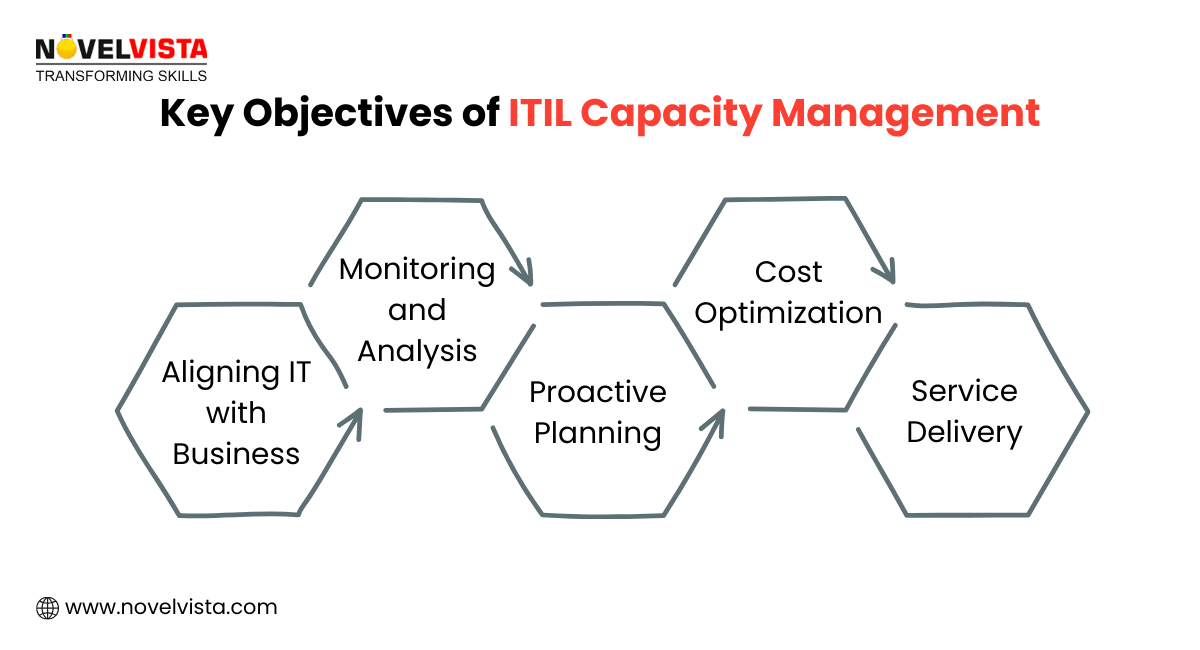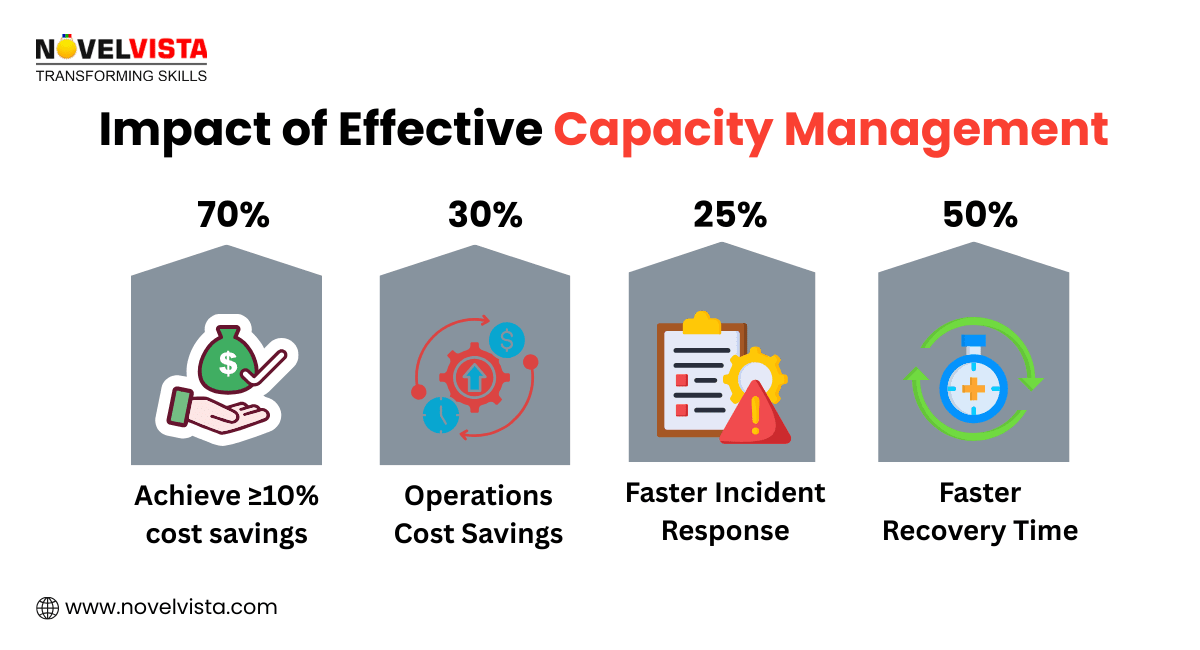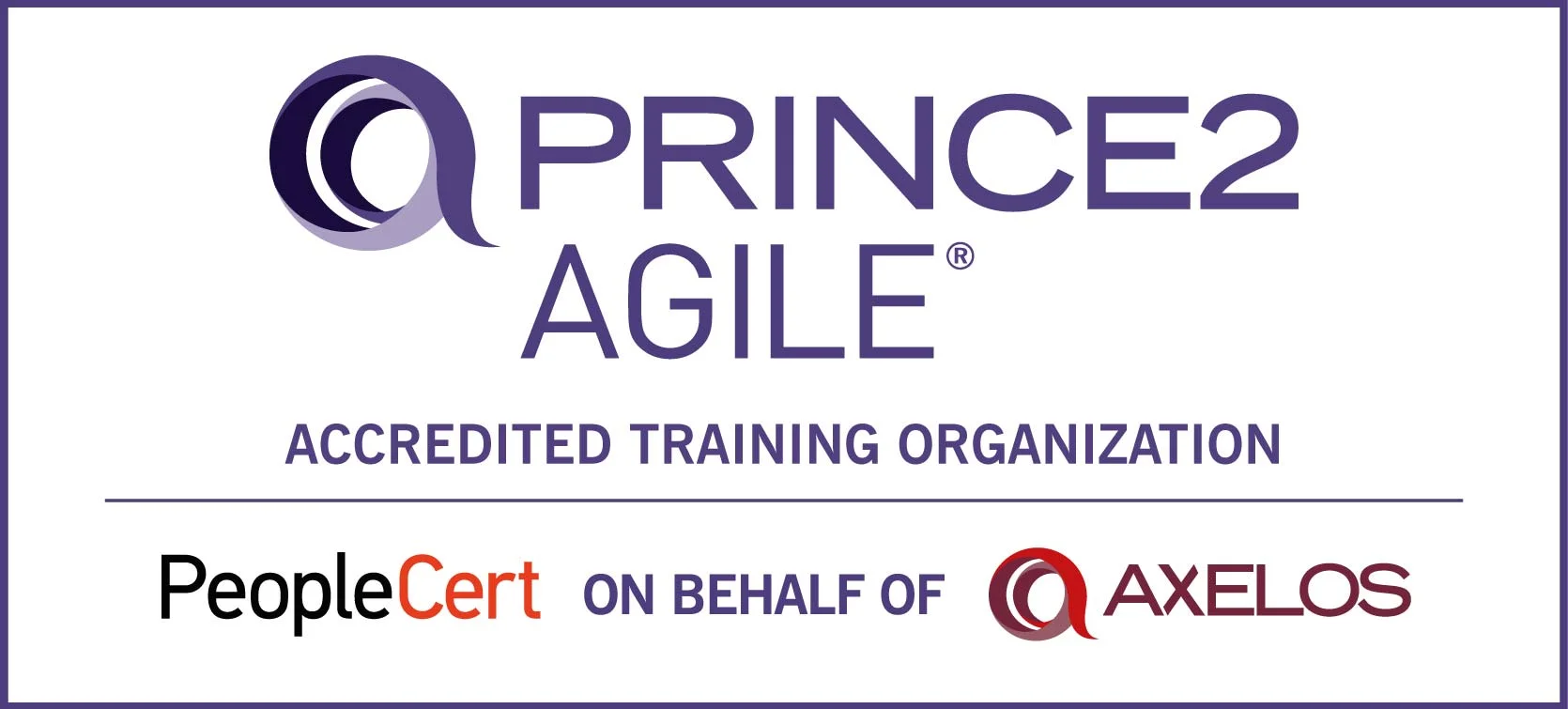- What is ITIL Capacity Management?
- Key Objectives of ITIL Capacity Management
- Importance and Benefits of Capacity Management
- Why Capacity Management Still Matters
- How to Implement ITIL Capacity Management: Step-by-Step
- Why Should I Implement Capacity Management?
- Core Components: What does ITIL Capacity Management Involve?
- Key Performance Indicators (KPIs)
- Real-World Applications and Tools
- Case Studies or Examples
- Regular Updates and Current Trends
- Conclusion:
- Next Step: Learn ITIL with NovelVista
ITIL Capacity Management is a cornerstone of effective IT Service Management (ITSM). But what exactly is ITIL Capacity Management? Simply put, it’s the practice of ensuring that your IT infrastructure and services have the right capacity, enough resources to meet demand without overspending or risking downtime. It’s a careful balance between supporting business growth and maintaining operational stability.
Understanding what is ITIL Capacity Management helps organizations avoid costly over-provisioning and frustrating under-provisioning. This blog will explore the essentials of Capacity Management in ITIL, its objectives, scope, strategies, tools, and the future trends shaping this critical ITSM practice.
What is ITIL Capacity Management?
Under the ITIL 4 framework, the ITIL Capacity Management ensures IT resources are planned and managed to meet current and future business demands in a cost-effective way. It translates business requirements into IT capabilities by monitoring, analyzing, and forecasting the use of hardware, software, networks, storage, and cloud resources.
Capacity Management in ITIL works hand-in-hand with other ITIL practices such as Availability Management (ensuring services are up and running) and Service Level Management (ensuring services meet agreed performance targets). Together, they form a holistic approach to delivering reliable and efficient IT services.
Key Objectives of ITIL Capacity Management
The goals of ITIL Capacity Management focus on balancing resource availability with business needs, cost constraints, and service performance. Key objectives include:

- Aligning IT with Business: Ensure IT infrastructure supports both current operations and future business growth. This alignment is crucial to prevent capacity shortfalls that could stall business processes.
- Monitoring and Analysis: Continuously track IT resource utilization and service performance to identify potential bottlenecks or wasted capacity.
- Proactive Planning: Anticipate demand changes and scale resources proactively to avoid outages or degradation of service quality.
- Cost Optimization: Right-size your IT resources to avoid the high costs of over-provisioning while ensuring performance targets are met.
- Service Delivery: Meet Service Level Agreements (SLAs) consistently by ensuring capacity is sufficient to handle workloads without failure or delay.
Importance and Benefits of Capacity Management
Why bother with capacity operation in the first place?
Done right, it leads to:
- Improved service quality with minimum outages or delays
- Cost savings by avoiding over-allocation and slowing down extra upgrades
- Informed decision-making by using real-time capacity information
- Better SLA compliance because of prepared resource allocation
And let’s not forget — effective IT performance management also improves customer satisfaction by guaranteeing consistent delivery of services.
Why Capacity Management Still Matters
Whether you’re a startup scaling fast or an enterprise trying to control cloud sprawl, capacity handling is what keeps your IT services humming.
With increasing complexity and controlled budgets, it’s not enough to react to delays after users complain. The ITIL method gives you the plan to be strategic, data-driven, and aligned with business needs.
For those looking to boost their skills, getting an ITIL certification is a great place to start. You’ll not only master capacity handling but also the broader service lifecycle that supports it.
Curious about what this certification involves? Check out this quick guide on ITIL Certification Meaning.
And if you’re wondering whether the effort pays off, yes, it does. Explore how ITIL certification adds value to your career and increases the opportunities in IT service management, cloud operations, and performance engineering.
How to Implement ITIL Capacity Management: Step-by-Step
Implementing Capacity Management ITIL involves a structured approach to align IT with business goals:
- Assess Current Capacity and Performance: Review existing IT resource utilization and service delivery metrics to understand your starting point.
- Identify Business Requirements and Forecast Demand: Work closely with business units to forecast future IT demand based on growth plans, product launches, or seasonal trends.
- Develop a Capacity Plan: Create a capacity management plan that aligns with both IT capabilities and business objectives, balancing performance and cost.
- Implement Monitoring and Analysis Tools: Deploy tools to continuously monitor IT resources and generate alerts for capacity thresholds.
- Optimize Resources for Cost and Efficiency: Use insights from monitoring to right-size infrastructure, including migrating workloads between on-premise and cloud where appropriate.
- Review and Adjust Continuously: Capacity management is not a one-time effort; regularly review performance data and update plans to adapt to changes.
Download: ITIL 4 Capacity Management Guide
Overcome common capacity challenges and keep your IT services stable, efficient, and disruption-free.
Why Should I Implement Capacity Management?
Implementing effective ITIL Capacity Management brings several clear advantages that benefit both IT teams and the broader organization:
- Improved Service Performance: By ensuring the right capacity is available at the right time, your IT services consistently meet or exceed performance targets, enhancing user satisfaction.
- Reduced Costs: Optimizing resource usage prevents overspending on unnecessary infrastructure or cloud capacity, saving significant costs.
- Increased Efficiency: Proactive capacity management allows IT teams to address bottlenecks and resource gaps before they affect services, leading to smoother operations.
- Better Business Alignment: When IT capacity planning is tied directly to business goals, IT becomes a true partner in enabling growth and agility.
- Reduced Risk of Outages: Forecasting and proactive scaling reduce the likelihood of outages caused by capacity shortages or spikes in demand.
Core Components: What does ITIL Capacity Management Involve?
At its core, capacity management is the process of confirming that your IT infrastructure and services are adequately resourced to meet current and projected business demands. It includes three sub-processes:
a. Business Capacity Management (BCM)
This ensures that future business requirements are considered and translated into IT requirements. It aligns IT capacity with long-term goals and growth.
b. Service Capacity Management (SCM)
This focuses on the performance and capacity of the IT services in use — such as analysing application performance and identifying potential bottlenecks.
c. Component Capacity Management (CCM)
Here, attention is paid to individual components of the infrastructure (servers, storage, bandwidth, etc.) to make sure they are operating within perfect thresholds.
Each of these layers supports a proactive and strategic approach to IT resource optimization, rather than reactive fire-fighting.
Key Performance Indicators (KPIs)
To measure success, organizations use specific KPIs related to Capacity Management ITIL:
- Resource Utilization Rate: Measures how effectively IT resources (CPU, memory, storage) are being used. Balanced utilization ensures neither waste nor overload.
- SLA Compliance Percentage: Tracks the percentage of time services meet their agreed performance levels, reflecting effective capacity planning.
- Forecast Accuracy: Compares predicted demand against actual resource usage, helping improve future capacity planning.
- Cost per Service Unit: Evaluates the cost efficiency of delivering each unit of service, highlighting opportunities for savings.
- Number of Performance-Related Incidents: Counts incidents caused by capacity issues, serving as a warning sign for under-provisioned resources.
Impact of Effective Capacity Management

Real-World Applications and Tools
Organizations across industries depend onITIL capacity planning to keep high performance maintained, especially during peak loads, seasonal spikes, or product launches.
Common tools used for IT performance management and capacity monitoring include:
- SolarWinds Capacity Planning Tool
- Dynatrace
- Nagios
- BMC TrueSight Capacity Optimization
- VMware vRealize Operations
These tools provide dashboards, alerts, and performance modeling, helping you proactively address issues before they disrupt service delivery.
If you are a beginner and just getting started with the ITIL approach, have a look at ITIL® 4 Foundation Certification to build a complete understanding of these processes and principles.
Case Studies or Examples
Let’s understand this with some real-world examples:
Case Study 1: E-commerce Platform
A fast-growing e-commerce company always used to face problems with normal service slowdowns during seasonal sales. By applying ITIL capacity planning, they shaped expected traffic boosts, adjusted cloud resource allocation in real time, and achieved 99.95% uptime during their biggest sales event of the year.
Result?A 30% improvement in transaction success rate and millions in extra revenue.
Case Study 2: Healthcare IT System
A regional healthcare provider needed to confirm that their patient data systems met stringent SLAs without over-investing in infrastructure. With resource optimization strategies, they right-sized applications, removed redundancy, and improved scalability in IT. Not only did they stay compliant, but they also reduced annual IT spend by 18%.
Regular Updates and Current Trends
Capacity management isn't a one-time investment. The world is always changing. So what's trending now?
a. AI and Machine Learning in Capacity Predicting
Modern tools now use machine learning to predict usage patterns and system behavior more precisely. This takes need for predicting to the next level — moving beyond historical trends to predictive performance metrics.
b. Hybrid Cloud Resource Allocation
Many companies are combining in-house and cloud resources. Smart capacity handling now includes planning all over hybrid environments — leveraging elasticity of cloud for variable workloads.
c. Integration with DevOps & Agile
Capacity planning is being added into Agile sprints and DevOps cycles. This make sure that resource planning is part of the build-release-monitor loop — not an afterthought.
d. Sustainable IT Practices
Reducing energy consumption and carbon footprints is now a key driver of capacity planning decisions. Eco-friendly IT is not just good for the planet — it also helps trim waste and costs.
Conclusion:
ITIL Capacity Management is essential for any organization seeking to balance IT performance, cost, and business growth. A proactive, data-driven approach helps avoid resource waste, ensures reliable service delivery, and aligns IT capacity with evolving business needs. By mastering capacity management in ITIL, organizations can drive operational stability and support their strategic goals effectively.
Next Step: Learn ITIL with NovelVista
Ready to deepen your understanding of ITIL Capacity Management and other critical ITIL practices? NovelVista’s ITIL 4 Foundation Certification Training provides hands-on, practical learning led by industry experts. With flexible learning options and real-world case studies, NovelVista equips you with the tools and knowledge to implement effective capacity management strategies in your organization.
Enroll today to advance your ITSM career and become a key player in delivering reliable, cost-efficient IT services!
Frequently Asked Questions
- Business Capacity Management – Align IT with business needs.
- Service Capacity Management – Monitor and manage service performance.
- Component Capacity Management – Track individual resource usage.
- Performance Analysis – Identify bottlenecks or inefficiencies.
- Capacity Plan Review – Update plans based on forecasts and trends.
Author Details

Mr.Vikas Sharma
Principal Consultant
I am an Accredited ITIL, ITIL 4, ITIL 4 DITS, ITIL® 4 Strategic Leader, Certified SAFe Practice Consultant , SIAM Professional, PRINCE2 AGILE, Six Sigma Black Belt Trainer with more than 20 years of Industry experience. Working as SIAM consultant managing end-to-end accountability for the performance and delivery of IT services to the users and coordinating delivery, integration, and interoperability across multiple services and suppliers. Trained more than 10000+ participants under various ITSM, Agile & Project Management frameworks like ITIL, SAFe, SIAM, VeriSM, and PRINCE2, Scrum, DevOps, Cloud, etc.
Course Related To This blog
ITIL4 Specialist Monitor Support and Fulfil Certification
ITIL4 Specialist Acquiring & Managing Cloud Services
ITIL 4 Specialist Sustainability in Digital & IT
ITIL® 4 Strategic Leader Digital And IT Strategy (DITS)
ITIL® 4 Specialist Drive Stakeholder Value
ITIL® 4 Specialist High Velocity IT
ITIL® 4 Strategist Direct, Plan & Improve
ITIL® 4 Foundation Certification
Confused About Certification?
Get Free Consultation Call









